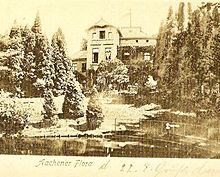Villa Flora Aachen
The Villa Flora , originally called Villa de Montrevel , is a villa-like country house in the style of historicism in Aachen - Burtscheid , which was converted into an apartment building in the 1990s.
history
In 1874 the Villa de Montrevel was built extra muros in front of the Marschiertor on the Eupener Landstrasse in front of Elisenruh . It was built for Countess Poulle de Montrevel, the wife of Gustav Alpert, and decorated with statues. In 1904, Carl Lehmann owned the now renamed Villa Flora . The house had been renamed after the goddess Flora, represented by a statue, and converted into a garden restaurant.
The restaurant, known as the “climatic health resort”, was located at the Eupenerstrasse small train station on Line F. A historical postcard of the Villa Flora does not show the building and property in their real proportions. The artist of this graphic representation has given everything a size. The illustration is wide according to the format of the postcard.
In 1905 the doctor Ferdinand Joseph Laaf bought the villa as a summer house. The Laaf family redesigned the villa according to their taste. The statue of the goddess Flora, which had been placed on the balcony until then, was moved to the park. In addition, a small devil figure was discovered while cleaning up. Legend has it that the Countess buried a treasure in the park after her bankruptcy . The entrance to the terrace was now decorated with an arched trellis. The property, which the family lived in from May to October, included a large park and a swan pond. The Kupferbach flowed through the pond.
The Laaf family sold the villa to the Jewish cloth manufacturer Otto Ganz around 1920 . From 1941 to 1943 the Villa Flora served as a so-called Jewish house . The house book of the ghetto Eupener Straße 249 has been preserved: published there, a total of 62 inmates are recorded. In this house book, when Otto Ganz's mother-in-law moved out on December 26, 1942, under the heading "New Apartment", the note "Gassed in Theresienstadt" can be found. In the neighboring house Eupener Straße 251, built in 1940, towards the end of the Second World War, the Allied mayor and lawyer Franz Oppenhoff (* 1902) was shot by an SS group on Wednesday, March 25, 1945. In the evening they asked Oppenhoff for a sandwich. When he turned away, he was murdered from behind. The Aachener Oppenhoff-Allee bears his name. He is the grandson of Franz Theodor Oppenhoff, President of the Aachen Regional Court, who lived as state procurator together with the painter Heinrich Franz Carl Billotte at Sandkaulstrasse 10 in Aachen.
In the 1990s, the villa was converted into an apartment building. A number of additional houses were built in the park.
Individual evidence
- ^ Entry "Lehmann, Carl, (Zur Flora), an der Steinebrück, Eupenerstr." In the Aachen address book 1904.
- ^ The Aachener Kleinbahn-Gesellschaft (AKB) ran the route F in the city network in 1905: Frankenberg Victoriaallee - Normaluhr - Alt-Linzenshäuschen . See article Tram Aachen .
- ↑ Werner Dümmler: Aachen in old postcards. Flechsig, Frankfurt am Main 1977, p. 80. The description "Today the swimming pool south is behind your building site." Is misleading, the hall is located at Amyastraße 8 behind the house Eupener Straße 17. The address of Villa Flora is Eupener Straße 249 (1904 with house number 11).
- ↑ H. LEPPER: From Emancipation to the Holocaust, Aachen 1994, pp. 1667 to 1672
Coordinates: 50 ° 45 ′ 40.7 ″ N , 6 ° 5 ′ 15 ″ E

